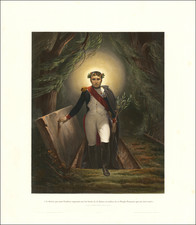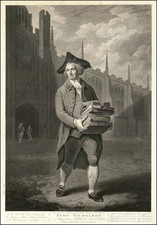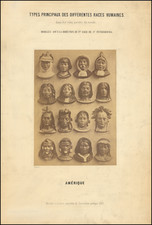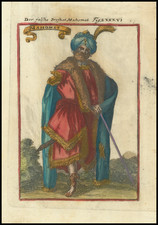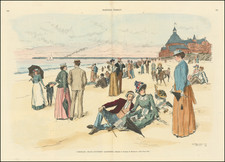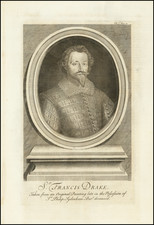This etching by Wenceslaus Hollar features a detailed portrait of Peter Paul Rubens, one of the most illustrious painters of the Baroque era. Rubens is depicted bust-length, facing slightly to the left, wearing a wide-brimmed hat and a cloak with a large collar. His attire is typical of the 17th century, emphasizing his status and sophistication. The portrait is framed by elaborate decorative elements, including scrolls, foliage, and artistic tools like a palette and brushes, symbolizing Rubens' profession as a painter. The print was published by Frans van den Wyngaerde.
The inscription below the image reads:
"Excellentiss. Dns: D. PETRVS PAVLVS RVBENIVS, pictorum Apelles, decus huius seculi, Orbis miraculum, Aulam Hispaniacam, Gallicam, Anglicam, Belgicam, penicillo suo illustravit. Quem gladio cinxit Philippus Quartus Hispaniarum Rex, et Equit: hui a S: Xaverio in Sanctæ Aulæ suæ Cenatio Bruxellensi, et ad Regem Angliæ Legatum Extraordinarium misit."
This inscription highlights Rubens' excellence and reputation as a painter, comparing him to Apelles of Kos, the renowned ancient Greek painter. It also mentions his influence and recognition in the courts of Spain, France, England, and Belgium, and his knighthood conferred by King Philip IV of Spain.
Wenceslaus Hollar, born on July 23, 1607, in Prague, was a prolific and accomplished Bohemian graphic artist of the 17th century.
Known to German speakers as Wenzel Hollar and to Czech speakers as Václav Hollar, he is celebrated for his masterful engravings and etchings. The turmoil of the Thirty Years' War, particularly the Sack of Prague, devastated Hollar's family, leading him to abandon his initial path towards a legal career and instead pursue the arts. His earliest surviving works date back to 1625 and 1626, showcasing the influence of Albrecht Dürer. In 1627, Hollar apprenticed under the esteemed engraver Matthäus Merian in Frankfurt, marking the beginning of his illustrious career.
During the early 1630s, Hollar resided in Strasbourg, Mainz, and Koblenz, capturing the essence of the Middle Rhine Valley through his depictions of towns, castles, and landscapes. In 1633, he moved to Cologne, where his talent began to attract significant attention. It was here, in 1636, that he caught the eye of Thomas Howard, the 21st Earl of Arundel, a renowned nobleman and art collector. Hollar joined Arundel on diplomatic missions to Vienna and Prague, and in 1637, he accompanied the Earl to England.
Upon settling in England, Hollar became part of Arundel's household, though he did not work exclusively for the Earl. He continued to create independently and for various authors and publishers. Following Arundel's death in 1646, Hollar commemorated him with a print designed by Cornelius Schut. Hollar's remarkable "View of Greenwich," published by Peter Stent, exemplified his early work in England and set a precedent for his meticulous and expansive cityscapes.
The English Civil War significantly impacted Hollar's career, although he remained productive. He withstood the siege of Basing House alongside royalist artists like Inigo Jones and William Faithorne. Despite the adversity, Hollar's output was prolific during this period, with numerous plates dated 1643 and 1644. Following his capture and subsequent escape during the siege of Basing House in 1645, Hollar relocated to Antwerp, where he reconnected with Arundel and produced some of his most acclaimed works, including cityscapes, seascapes, and intricate studies of nature.
In 1652, Hollar returned to London, continuing his work with notable publishers and illustrating various significant texts, including Ogilby's Virgil and Homer, Stapylton's Juvenal, and Dugdale's Warwickshire, St Paul's, and Monasticon.
Following the Great Fire of London in 1666, Hollar produced his famous "Views of London," capturing the city's devastation and subsequent rebuilding. In 1668, King Charles II commissioned him to document Tangier's town and forts. His return voyage included a notable naval engagement, which Hollar later etched for Ogilby's Africa. Hollar continued to produce well-regarded works until his death on March 25, 1677, in London, where he was buried at St Margaret's Church, Westminster.
Hollar's legacy endures through an extensive body of work, including some 400 drawings and 3000 etchings. His plates, numbering around 2740, encompass a vast array of subjects, from topographical views and portraits to intricate depictions of nature and architecture.
Collections of Hollar's work are held in prestigious institutions such as the British Museum, Windsor Castle, the National Gallery in Prague, and the Virginia Museum of Fine Arts. His contributions to graphic art are celebrated in catalogues by George Vertue, Gustav Parthey, and Richard Pennington, with a comprehensive catalogue published in the New Hollstein German series. Hollar's work remains accessible through digital collections, notably at the University of Toronto and the Folger Shakespeare Library.
The Wenceslaus Hollar Secondary School of Art in Prague honors his name, ensuring that his artistic legacy continues to inspire future generations.









